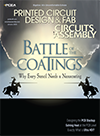News
For the quarter, Valor reported revenues of about $7.5 million, tying a company record, up from $6.3 million a year ago. Cash flow improved by $1 million during the quarter.
First-half revenues were up 17.3% to $14.6 million while net was $301,000, reversing a loss of $539,000.
President and CEO Ofer Shofman said in a press statement, "I am delighted with these results. [W]e expect to maintain our growth rate in the second half.
Flemington, NJ-- DEK (dek.com) has licensed its VectorGuard stencil technology to Christian Koenen GmbH. The Munich, Germany-based company will provide DEK customers with a second source for the stencils in Germany, Austria and Switzerland.
The companies signed the supply and licensing agreement in June at SMT 2004 in Nuremberg. Christian Koenen will manufacture the stencils from foil blanks supplied by DEK, and will supply its customers with the corresponding stencil frames.
The VectorGuard system was introduced last year to enhance user-friendliness, handling, storage and turnaround time for frame-mount stencils users. Extruded aluminium safety edges and plastic corner pieces make the stencils easy to remove for recycling and easy to mount and dismount from the new frame without special equipment.
To wit: A recent announcement by a major office equipment retail chain and a leading PC OEM to recycle old computers for free. Two weeks ago, Office Depot and H-P announced programs to takeback outdated machines at no charge to consumers. Currently, less than 10% of electronics are recycled, according to the Silicon Valley Toxics Coalition.
Vijay Wakharkar of Intel drove the point home during a special invite-only session on packaging trends during Semicon West. In a four-hour session at the Marriott Hotel cosponsored by SEMI's International Electronics Manufacturing Technology Symposium and Henkel Technologies, several experts spoke on coming challenges in packaging.
With package costs beginning to exceed even the semiconductor die, more attention will be paid to these critical interfaces between the brains -- the chip -- and the boards. Wakharkar called attention to particular "green" trends, saying, "I think customers will ask about chemicals in packages."
Wakharkar described several other trends, including the convergence of computing and communications. The result, he says, will be packages that are more complex, with higher I/O counts, and die stacking and pinning. For example, Intel is working on stacking six to eight dice in a single package. In turn, materials suppliers will have to come up with combinations that withstand or "smooth" the heat spread from chip to package.
Furthermore, gains will continue to come in tighter densities. By next year, he says, manufacturers can expect BGA pitches to decrease to 0.3 mm for CSPs, and 0.6 mm for what he calls "cost-performance" packages.
Further evidence of green's gains: lead-free solder bumps. According to Jan Vardaman of TechSearch International, "some increase in the next year or so" should be expected for lead-free bumps. Fujitsu, she notes, uses lead-free bumps in all products for internal use.
Vardaman also noted a shift in packages for memory devices. Such applications are shifting to FBGA and wafer-level packaging from TSOPs, she says. Her forecasts call for the number of 200-mm wafers shipped in WLPs to grow from 750,000 wafers this year to 2.1 million next year and 4 million in 2006.
Other presentations covered low k devices and copper interconnects, lead-free material sets and high speed dispensing. Speakers included Mike Steidel of Amkor Technology, Kishor Desai of LSI Logic, Dev Malladi of Sun Microsystems, Steve Adamson of Asymtek and Henkel's Gordon Fisher, Jim Huneke and Michael Todd.
"The goal was to educate attendees about the power of partnering with industry leaders and illustrate how these partnerships can yield solutions to some of the biggest challenges in semiconductor packaging," says Bhavesh Muni, business manager of semiconductor packaging materials at Henkel, in a press statement. Muni said the turnout -- 120 persons -- and positive returns would lead to another symposium at Semicon West next year.
For copies of the proceedings, call 626-968-6511.
Press Releases
- Benchmark Appoints Josh Hollin as Senior Vice President and Chief Technology Officer
- 2026 IEEE Electronic Components and Technology Conference Student Innovation Challenge Pre-registration Deadline Extended to January 11, 2026
- PCBsync PCB Assembly Introduces Full-Scale Electronic Manufacturing Service
- Magic Leap Partners with Pegatron for AR Glasses Components Production


